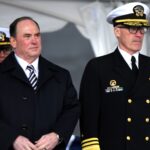
The Navy’s research head revealed a new strategic direction document last week at the 2017 Naval Future Force Science and Technology Expo.Rear Adm. David Hahn, chief of Naval Research (CNR) and head of the Office of Naval Research (ONR), unveiled the new framework, which is meant to echo a change in thinking about how naval researchers need to accelerate capabilities for warfighters.“It outlines how we align research to naval priorities, allocate our investment portfolios and accelerate decision-making to speed business…

 By
By 











